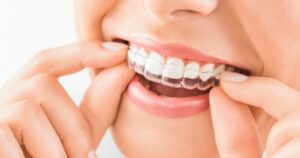Welcome to My Smile Orthodontics, where your journey to a confident, healthy smile begins. One of the most common questions we hear from our patients, especially those new to orthodontic treatment, is, “What can I eat with braces?” It’s a valid concern because making the right food choices is essential for your comfort and the effectiveness of your orthodontic treatment.
In this guide, we’ll explore the ins and outs of eating with braces, providing you with valuable insights, tips, and meal ideas to ensure your orthodontic journey is as smooth as possible. Whether you’re a teenager or an adult seeking orthodontic care, knowing what to eat is a fundamental part of your treatment.
So, let’s dive in and discover the foods that will keep your smile on track while wearing braces. Whether you’re a fan of crunchy snacks, hearty meals, or sweet treats, we’ll help you find delicious and braces-friendly options to enjoy throughout your orthodontic adventure.
Foods to Avoid
While there are plenty of delicious options to enjoy with braces, there are also some foods you should steer clear of to protect your braces and avoid potential damage. Here are some categories of foods and specific examples to be cautious about:
Hard and Crunchy Foods
These can pose a risk to your braces by potentially breaking wires or brackets. Examples include:
- Nuts: Almonds, peanuts, and hard nuts.
- Hard candies: Jolly Ranchers, jawbreakers, or any hard sweets.
- Popcorn: The hulls can get stuck between your teeth and braces.
- Chips: Thick, hard chips like kettle-cooked potato chips.
Sticky and Chewy Foods
These can also damage your braces and make them harder to clean. Examples include:
- Chewing gum: Especially gum with sugar, as it can lead to tooth decay.
- Sticky candies: Taffy, caramel, and gummy candies.
- Chewy snacks: Bagels, licorice, and tough jerky.
Tough and Hard-to-Bite Foods
These can be difficult to eat without putting extra pressure on your braces. Examples include:
- Corn on the cob: While delicious, it’s best to cut the kernels off.
- Raw vegetables: Carrots, bell peppers, and celery should be cut into small pieces.
- Hard fruits: Apples and pears should be sliced or diced.
- Avoid Biting with Front Teeth: Try not to bite directly into foods with your front teeth, as this can strain your braces. Instead, cut them into smaller, more manageable pieces.
Sugary and Acidic Foods
Limit your consumption of sugary snacks and acidic drinks, as they can contribute to tooth decay and demineralization. If you do indulge, make sure to brush your teeth thoroughly afterward.
Tough Meats
While meats are an excellent source of protein, some cuts can be challenging to chew. Consider cooking meat until it’s tender or choosing softer options.
By avoiding these foods and being mindful of what you eat, you’ll reduce the risk of damaging your braces and ensure a smoother orthodontic experience. Remember, the better you take care of your braces, the sooner you’ll achieve that beautiful, confident smile you’re working towards.
Braces-Friendly Foods
Now that you know what foods to avoid, let’s explore the wonderful world of braces-friendly foods. These options are not only safe for your braces but can also contribute to your overall oral health during orthodontic treatment. Here are some categories of braces-friendly foods and specific examples:
Soft Foods
Soft foods are gentle on your braces and teeth. They include:
- Yogurt: A calcium-rich option that’s easy to eat.
- Pudding: Creamy and smooth for a sweet treat.
- Applesauce: A great alternative to whole apples.
- Mashed Potatoes: Soft and delicious comfort food.
Cooked Vegetables
Cooking vegetables can make them easier to chew. Consider:
- Steamed broccoli: Softened and nutritious.
- Cauliflower: Cooked until tender.
- Green beans: Lightly cooked or canned.
Dairy Products
Dairy is essential for strong teeth and bones. Try:
- Cheese: A calcium-rich snack that’s low in sugar.
- Milk: A classic choice for calcium and vitamin D.
- Smoothies: Blend yogurt, fruit, and milk for a nutritious drink.
Soft Fruits
Enjoy these fruits without the risk of damaging your braces:
- Bananas: Soft and easy to eat.
- Berries: Blueberries, strawberries, and raspberries are soft options.
- Peaches: Sliced or canned peaches are a tasty choice.
Seafood
Seafood is typically easy to chew and offers essential nutrients:
- Salmon: A great source of omega-3 fatty acids.
- Tuna: Canned tuna is soft and protein-packed.
Pasta and Rice
These staples can be part of your braces-friendly diet:
- Macaroni and cheese: Soft pasta with calcium-rich cheese.
- Rice dishes: Like risotto or pilaf.
Soft Breads
Choose bread that’s easy to bite and won’t strain your braces:
- Sandwiches: Use soft fillings like egg salad or deli meats.
- Tortillas: Soft tortillas are perfect for wraps.
Smooth Nut Butters
Peanut butter and almond butter are excellent sources of protein. Just make sure they’re not too sticky.
- Soups: A variety of soups, from chicken noodle to tomato, can be part of your braces-friendly menu.
- Eggs: Eggs are versatile and can be prepared in many ways, from scrambled to hard-boiled.
Remember to maintain good oral hygiene during your orthodontic treatment. Brush your teeth, gums, and braces after meals to prevent food particles from getting trapped. By choosing braces-friendly foods, you can continue to enjoy delicious and nutritious meals while protecting your braces and maintaining a healthy smile.
Meal Ideas
Now that you have a list of braces-friendly foods, let’s put together some tasty meal ideas that you can enjoy during your orthodontic journey. These meals are not only gentle on your braces but also nutritious and satisfying.
Braces-Friendly Breakfast
Yogurt Parfait
Layer yogurt with soft fruits like bananas or berries. Add a drizzle of honey and some granola for texture.
Lunch Options
- Grilled Cheese Sandwich: A classic favorite. Use soft bread and melt cheese for a gooey delight.
- Chicken and Rice Soup: Warm and soothing, this soup combines soft-cooked rice with tender chicken pieces.
Dinner Delights
- Pasta Primavera: Cooked pasta with a medley of steamed vegetables and a light sauce.
- Baked Salmon: A healthy choice with a side of mashed potatoes and steamed broccoli.
Snacks
- Cheese and Crackers: A quick and nutritious snack.
- Smoothie: Blend yogurt, banana, and a handful of berries for a refreshing treat.
Desserts
- Soft-Serve Ice Cream: A braces-friendly alternative to hard ice cream.
- Rice Pudding: Creamy and sweet comfort food.
Beverages
- Milkshakes: Blend milk, ice cream, and your favorite flavorings for a satisfying drink.
- Fruit Infused Water: Add slices of soft fruits like citrus or berries to your water for a hint of flavor.
Remember to incorporate a variety of these foods into your daily diet to ensure you receive a balance of nutrients. While it’s important to stick to braces-friendly foods, you can still enjoy delicious and wholesome meals.
Tips for Eating with Braces
Eating with braces can take a little getting used to, but with some practice and these helpful tips, you’ll navigate mealtimes with ease:
Take Small Bites
Cut or break your food into smaller, more manageable pieces. This makes it easier to chew and reduces the risk of damaging your braces.
Chew Carefully
Chew with your back teeth and avoid biting into hard or crunchy foods with your front teeth. This reduces the pressure on your braces.
Avoid Sticky and Hard Foods
Steer clear of foods that are excessively sticky (like caramel or taffy) or very hard (like nuts or hard candies). These can damage your braces or get stuck in them.
Use Utensils
When possible, use utensils like a knife and fork to cut and eat food. This minimizes the contact between your braces and food.
Rinse After Meals
Rinse your mouth with water after eating to remove any food particles that may be trapped in your braces. This reduces the risk of plaque buildup and cavities.
Floss Daily
Flossing can be a bit trickier with braces, but it’s crucial for maintaining oral hygiene. Use special floss threaders or orthodontic floss to clean between your teeth and around your braces.
Attend Regular Checkups
Keep up with your orthodontic appointments. Your orthodontist will make necessary adjustments and ensure your treatment progresses smoothly.
Use Wax for Discomfort
If your braces are causing irritation or sores in your mouth, orthodontic wax can provide relief. Apply it to the braces’ edges that are causing the discomfort.
Stay Hydrated
Drinking water throughout the day helps keep your mouth clean and your braces free from debris.
Emergency Kit
Carry a small kit with essentials like a travel toothbrush, toothpaste, orthodontic wax, and floss for on-the-go braces care.
Remember that adjusting to braces is a temporary phase in your orthodontic journey. As you become more accustomed to them, you’ll find it easier to enjoy a wide variety of foods while maintaining good oral hygiene. If you have any concerns or questions about eating with braces, don’t hesitate to reach out to your orthodontist for guidance and support.
Common Challenges
While braces are a fantastic tool for achieving a beautiful, healthy smile, they do come with some common challenges. Here’s what you might encounter during your orthodontic journey:
Discomfort
It’s typical to experience some discomfort or soreness, especially in the first few days after getting braces and following adjustments. Over-the-counter pain relievers can help, and orthodontic wax can alleviate irritation caused by braces rubbing against your cheeks or lips.
Dietary Adjustments
Adapting to a braces-friendly diet can be challenging. You’ll need to avoid certain foods to prevent damage to your braces. But remember, it’s a temporary sacrifice for a long-term gain – a beautifully aligned smile.
Oral Hygiene
Keeping your teeth and braces clean is crucial to prevent issues like cavities and gum disease. It might take extra time and patience to floss and brush properly with braces, but it’s essential.
Orthodontic Appointments
You’ll need to attend regular orthodontic appointments for adjustments and checkups. These appointments are essential for ensuring your treatment progresses as planned.
Speech Changes
Some people experience minor speech changes initially, such as a slight lisp. Don’t worry; this typically resolves as you adjust to the presence of braces in your mouth.
Orthodontic Emergencies
Occasionally, a wire or bracket may come loose or cause discomfort. Your orthodontist can address these issues, so it’s essential to contact them promptly.
Self-Consciousness
Many people feel self-conscious about their appearance with braces, especially initially. Remember that braces are a common part of many people’s lives, and the end result – a beautifully aligned smile – is worth it.
Treatment Duration
Orthodontic treatment can last anywhere from several months to a few years, depending on your specific needs. Patience is key to achieving the desired results.
By understanding these common challenges and working closely with your orthodontist, you can navigate your braces journey more smoothly. Remember that the end goal – a healthy, confident smile – is well worth the effort and temporary inconveniences along the way. Your orthodontist is there to support you at every step and address any concerns you may have.
Conclusion
The journey with braces is an investment in your oral health and a confident, beautiful smile. While it comes with its unique set of challenges, the benefits far outweigh any temporary inconveniences.
By adhering to a braces-friendly diet, practicing excellent oral hygiene, and following your orthodontist’s advice, you can ensure that your treatment progresses smoothly. Remember, the discomfort and adjustments you experience are all steps on the path to achieving the smile you’ve always wanted.
At My Smile Orthodontics, we’re here to support you throughout your orthodontic journey. Our experienced team is dedicated to providing the best care and guidance to help you achieve your desired results.
If you have any questions, concerns, or need assistance with your braces, don’t hesitate to reach out to us. Your orthodontist is your partner in this transformative process, and together, we’ll work towards the confident and healthy smile you deserve.
So, as you embark on your braces adventure, keep your eyes on the prize – a radiant smile that will light up your life for years to come.













